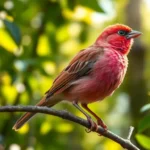We’ve all experienced that magical moment when a rare bird appears in our backyard or during a nature walk. The excitement builds as we grab our binoculars and watch in wonder. But how many of those incredible sightings do we actually remember weeks or months later?
A bird watching journal transforms these fleeting encounters into lasting memories and valuable data. We’re not just talking about a simple notebook – we’re discussing a comprehensive system that elevates your birding experience from casual observation to meaningful documentation. Whether you’re spotting your first cardinal or tracking migration patterns across seasons, a well-maintained journal becomes your personal field guide filled with unique discoveries.
The best part? Starting a bird watching journal requires no special skills or expensive equipment. We’ll show you exactly how to create and maintain a journal that captures every detail of your birding adventures while helping you become a more observant and knowledgeable birder.
Choose the Right Bird Watching Journal Format for Your Needs
Finding the perfect journal format is crucial for maintaining consistent birding records that you’ll actually use in the field.
Physical vs Digital Bird Watching Journals
Physical journals offer tactile satisfaction that many birders find irreplaceable. We can sketch bird features quickly without switching between apps, making field identification easier when you’re tracking a fast-moving warbler or documenting unusual plumage patterns. Traditional notebooks don’t require battery power or worry about screen glare in bright sunlight.
Digital journals provide search capabilities that transform how we access our birding data. Apps like eBird automatically sync with global databases, contributing to citizen science projects while tracking your personal statistics. Cloud storage ensures you’ll never lose years of observations, even if your phone takes an unexpected dip in a marsh.
Hybrid approaches combine both formats effectively. We recommend starting entries in a pocket field notebook, then transferring detailed observations to digital platforms later. This method captures spontaneous sightings while building comprehensive long-term records.
Size and Portability Considerations
Pocket-sized journals measuring 3×5 inches fit easily in binocular cases and hiking pockets. These compact formats work well for quick species lists and basic behavioral notes during active birding sessions. Small journals weigh less than 4 ounces, making them ideal for long hiking expeditions where every ounce matters.
Standard 5×8 inch notebooks provide more writing space for detailed descriptions and field sketches. We find this size perfect for stationary birding locations like blind watching or backyard observation sessions. Medium formats offer the right balance between portability and usable writing area.
Full-size journals measuring 8.5×11 inches excel for comprehensive documentation projects. Large formats accommodate detailed habitat maps, extensive species accounts, and weather data tables. These work best for car-based birding adventures where weight isn’t a primary concern.
Weather-Resistant Features
Waterproof paper made from synthetic materials like Rite in the Rain products withstand sudden downpours and morning dew. We’ve tested these journals in heavy rain conditions, and pencil or all-weather pen marks remain legible even when completely soaked. Synthetic paper costs more but prevents the heartbreak of losing months of observations to unexpected weather.
Water-resistant covers protect your journal’s binding and pages from moisture damage. Journals with vinyl or laminated covers shed light rain effectively, while full waterproof cases provide complete protection during severe weather birding. Hard covers also protect pages from crushing in overstuffed backpacks.
Tear-resistant pages prevent wind damage during field use. Journals with heavier paper stock (at least 20lb weight) resist tearing when you’re writing in windy conditions or flipping pages with wet hands. Spiral binding allows pages to fold back completely, making one-handed writing possible while holding binoculars.
Essential Information to Record in Your Bird Watching Journal

Your bird watching journal becomes most valuable when it captures exact details that transform simple sightings into comprehensive records. We’ll explore the core elements that make every journal entry meaningful and scientifically useful.
Species Identification and Common Names
Species identification forms the foundation of every quality bird watching journal entry. We recommend recording both the common name and scientific name whenever possible to eliminate confusion across different regions. Common names like “Robin” might refer to different species in North America versus Europe, but Turdus migratorius specifically identifies the American Robin.
Field marks deserve detailed attention in your identification notes. Document distinctive features like bill shape, wing bars, tail length, and unique coloration patterns that helped you confirm the species. Size comparisons work exceptionally well, such as “smaller than a crow but larger than a sparrow.”
Confidence levels add scientific value to your species records. We suggest using a simple scale like “certain,” “probable,” or “possible” to indicate how sure you felt about each identification. Uncertain identifications become learning opportunities when you return to research the species later.
Date, Time, and Location Details
Date and time stamping creates the temporal framework that makes your journal entries scientifically valuable. We always record the exact date, arrival time, and departure time for each birding session. Migration patterns, breeding seasons, and daily activity cycles all depend on precise timing data.
Location details should include multiple levels of specificity for maximum usefulness. Start with the general area like “Central Park, New York City,” then narrow down to exact spots like “Turtle Pond north shore” or “Shakespeare Garden pathway.” GPS coordinates add precision that helps you relocate productive birding spots.
Weather conditions at the time of observation influence bird behavior significantly. Temperature, wind direction and speed, precipitation, and cloud cover all affect which species you’re likely to encounter and how they behave.
Weather Conditions and Habitat Descriptions
Weather documentation goes beyond simple temperature readings to capture conditions that impact bird activity. We record wind patterns because many species become more active during calm periods, while raptors often soar during windy conditions. Barometric pressure changes can trigger feeding frenzies before storms arrive.
Habitat descriptions provide crucial context for understanding why certain species appeared in exact locations. Document the vegetation types, water sources, elevation, and surrounding industry features that characterize each birding spot. Woodland edges, wetland margins, and open grasslands each attract different bird communities.
Seasonal changes in habitat deserve special attention in your journal entries. Spring wildflowers attract insects that draw insectivorous birds, while autumn seed production brings granivorous species to exact plants and trees.
Behavioral Observations and Notes
Behavioral observations transform your journal from a simple species list into a rich behavioral study. We document feeding behaviors, noting what birds eat and how they obtain food. Foraging techniques like ground scratching, bark probing, or aerial insect catching reveal important ecological relationships.
Social interactions provide fascinating insights into bird communication and hierarchy. Record aggressive encounters, courtship displays, flocking behavior, and parent-offspring interactions when you observe them. These behaviors often occur during exact seasons and times of day.
Vocalizations deserve detailed descriptions in your behavioral notes. We describe calls and songs using phonetic spellings, musical comparisons, or rhythm patterns that help us remember and identify species later. Note whether birds were calling, singing, or remaining silent during your observations.
Set Up an Effective Bird Watching Journal Organization System

Organizing your bird watching journal transforms scattered observations into valuable data that’s easy to access and analyze. We’ll explore systematic approaches that help you find exact entries quickly while maintaining the natural flow of your field notes.
Create Species Index Pages
Alphabetical species indexes make locating exact birds effortless when reviewing months of observations. We recommend dedicating the first few pages of your journal to create a running list of every species you encounter, organized alphabetically by common name.
Include page numbers next to each species entry to create quick reference points throughout your journal. This system allows you to flip directly to detailed observations without scanning through dozens of unrelated entries.
Track first sightings by marking new species with asterisks or highlighting them in your index. Many birders find tremendous satisfaction in reviewing their “life list” chronologically and celebrating milestone discoveries.
Update regularly by adding new species to your index immediately after recording field observations. Consistent maintenance prevents the frustrating task of backtracking through weeks of entries to compile missing references.
Develop a Personal Coding System
Standardized abbreviations streamline note taking in the field when speed matters most during active birding sessions. Common codes include “M” for male, “F” for female, “Juv” for juvenile, and “FL” for flyover sightings.
Weather symbols capture conditions quickly using simple drawings like circles for sun, wavy lines for wind, or droplets for rain. These visual shortcuts save writing time while preserving important environmental context that influences bird behavior.
Confidence indicators help you assess identification certainty using systems like question marks for uncertain sightings or exclamation points for exciting discoveries. We suggest using a simple scale from 1 to 5 to rate your confidence level for each identification.
Behavior codes document activities efficiently using abbreviations like “F” for feeding, “N” for nesting, “S” for singing, or “P” for preening. Creating your own consistent system ensures you’ll remember what each code means when reviewing older entries.
Use Maps and Location References
Sketch simple maps directly in your journal to mark exact birding locations and create visual references for future visits. Basic landmarks like parking areas, trail intersections, or distinctive trees help pinpoint productive spots.
Record GPS coordinates for exceptional birding locations to ensure you can return to the same productive areas. Many smartphones provide precise coordinates that you can quickly jot down alongside your species observations.
Note exact microhabitats within broader locations, such as “oak grove near pond” or “brushy edge of meadow,” to understand habitat preferences better. These detailed location notes reveal patterns in where different species prefer to forage and nest.
Create location codes for frequently visited spots using memorable abbreviations like “CP” for Central Park or “BR” for the local nature preserve. This coding system saves writing space while maintaining clear geographic references in your entries.
Include Detailed Field Sketches and Visual Documentation
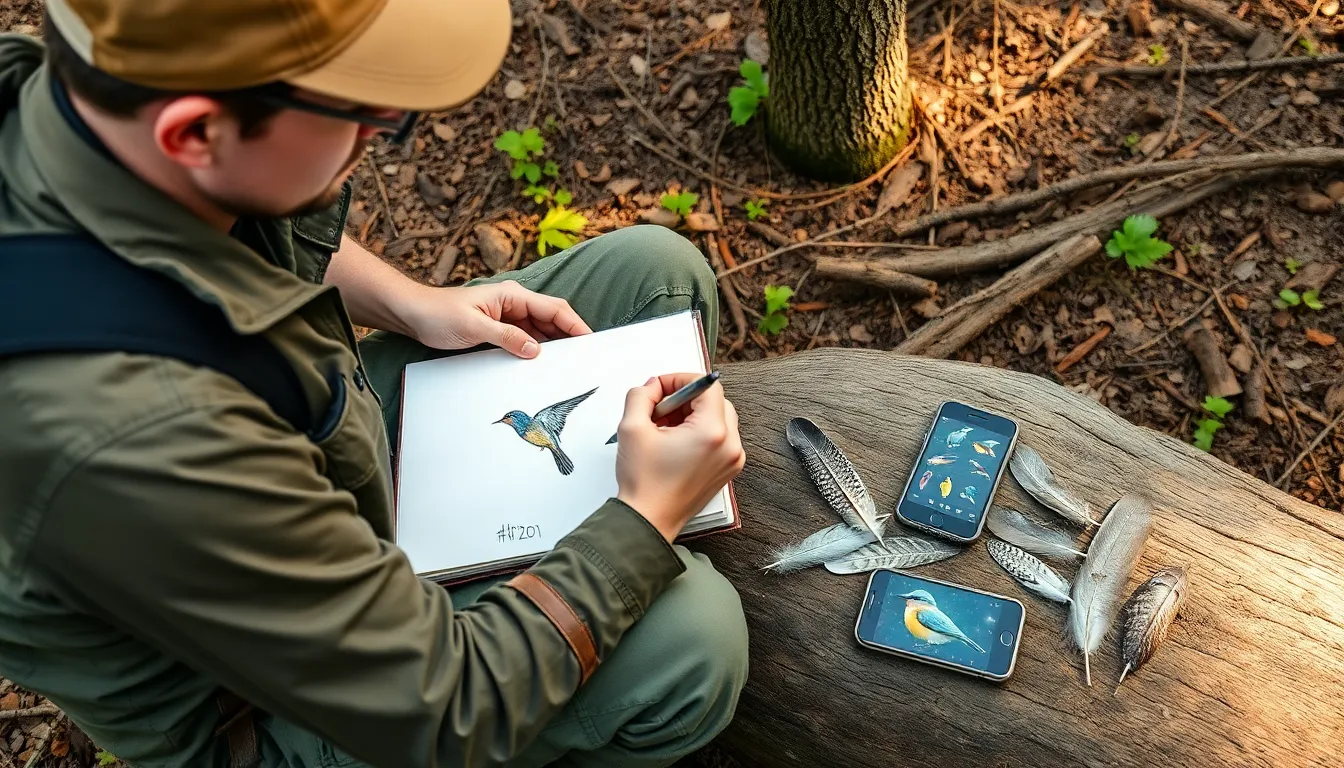
Visual documentation transforms our bird watching journal into a comprehensive field guide that captures details our memory might miss. Sketches and photos help us remember distinguishing features and create lasting records of our encounters.
Quick Sketch Techniques for Field Identification
Basic shape sketching starts with simple oval or circular outlines that capture the bird’s overall proportions. We focus on head size relative to body and tail length compared to wingspan. Drawing these fundamental shapes first helps us establish accurate proportions before adding details.
Feature emphasis techniques highlight the most distinctive characteristics that aid identification. We draw oversized bills for species like pelicans or toucans and exaggerated crests for birds like cardinals or blue jays. Emphasizing unique features makes our sketches more useful for future reference and species confirmation.
Quick notation systems use symbols and abbreviations to speed up our field documentation. We mark eye rings with circles around the head sketch and use arrows to indicate wing bars or distinctive markings. These rapid notation methods let us capture important details without spending excessive time drawing.
Field mark prioritization focuses on the most diagnostic features first before adding secondary details. We sketch bill shape and size initially since these features often distinguish between similar species like hawks or flycatchers. Wing patterns and tail shapes come next as they provide additional identification clues.
Photography Integration Methods
Photo reference coordination links our sketches directly to digital images for comprehensive documentation. We assign matching numbers to both sketches and photos in our journal entries. This cross referencing system helps us compare field observations with detailed photographic evidence later.
Smartphone integration strategies use mobile apps to enhance our journal documentation workflow. We take quick reference photos during sightings and transfer the best images to our journal pages using portable printers or photo corners. Many birders print wallet sized photos that fit perfectly in standard journal formats.
Digital annotation techniques overlay our handwritten notes directly onto printed photographs using fine tip pens. We circle distinctive features and draw arrows pointing to key field marks that might be subtle in the original image. These annotated photos become powerful learning tools for future birding sessions.
Comparison layouts place multiple photos or sketches of similar species on facing journal pages. We create side by side comparisons of confusing species like Cooper’s hawks versus sharp shinned hawks. These visual comparisons help us learn subtle differences and improve our field identification skills.
Feather and Track Recording
Feather documentation methods preserve and catalog molted feathers we find during our birding adventures. We tape feathers directly into our journals using clear tape or photo mounting corners. Each feather entry includes the species name, location found, and date of discovery for future reference.
Track impression techniques capture footprint evidence using simple field materials like pencil rubbings or smartphone photos. We place paper over clear tracks and rub with pencil sides to create detailed impressions. These track records help us identify bird activity in areas where we might not see the actual birds.
Scale reference systems include common objects like coins or rulers in our photos to show actual size. We photograph feathers next to quarters to demonstrate their true dimensions. Size references become crucial when trying to identify species from feather or track evidence alone.
Habitat correlation notes connect our feather and track findings to exact environmental conditions and locations. We record whether we found owl pellets near roosting sites or shorebird tracks along mudflats. These habitat connections help us understand bird behavior patterns and predict where we might find similar evidence in the future.
Track Seasonal Patterns and Migration Data

Tracking seasonal changes in our bird watching journal transforms routine observations into valuable scientific data. We’ll discover fascinating patterns that reveal the natural rhythms of our local bird communities.
Monthly Species Counts and Trends
Monthly tallies provide our clearest window into seasonal bird population changes. We recommend creating a simple table format with species names in the left column and monthly counts across the top row.
Recording species abundance each month reveals dramatic population shifts that occur throughout the year. Cardinals might show consistent numbers from January through December, while warblers appear in massive waves during May and September. We’ll notice that some species like Dark-eyed Juncos arrive in October and disappear by April.
Tracking these patterns helps us predict optimal birding times for exact species. Our journal entries might show that Indigo Buntings peak during the second week of May, giving us targeted opportunities for future observations. We can also identify unusual population spikes or declines that might indicate environmental changes in our area.
Creating monthly graphs from our count data reveals trends that numbers alone might miss. We’ll spot gradual increases in year-round resident populations or sudden drops that could signal habitat changes or weather impacts.
First and Last Sighting Records
First arrival and last departure dates create our personal migration calendar for each species. We mark these milestone sightings with special symbols or highlighting in our journals to make them easy to reference.
Recording precise first sightings helps us recognize early or late migrants compared to typical patterns. Our journal might show that Ruby-throated Hummingbirds usually arrive between April 15-20, making an April 5th sighting noteworthy. We’ll develop expectations for when to start watching for returning spring migrants.
Last sighting dates prove equally valuable for understanding fall migration timing. We might discover that most warblers disappear by mid-October, but Yellow-rumped Warblers linger into November. These records help us plan late-season birding trips to catch stragglers.
Comparing our first and last dates across multiple years reveals shifts in migration timing. Climate change impacts become visible when we notice species arriving earlier or departing later than historical patterns. We’ll create valuable citizen science data by maintaining consistent records over time.
Breeding Season Observations
Breeding behaviors transform our journals into intimate portraits of avian family life. We record courtship displays, nest building activities, and territorial behaviors that occur during each species’ reproductive season.
Documenting nest locations and success rates provides insights into local habitat quality. Our entries might track a pair of House Wrens from initial territory establishment through fledgling departure. We’ll note nest materials, construction timeline, and factors that influence nesting success or failure.
Recording breeding plumage changes helps us understand species identification throughout the season. Male American Goldfinches transform from dull winter brown to brilliant yellow during breeding season. We’ll capture these dramatic changes through detailed descriptions and sketches.
Fledgling observations mark the culmination of successful breeding efforts. We record approximate fledge dates, family group sizes, and juvenile identification features. These observations help us understand local population productivity and species-exact parental care strategies.
Enhance Your Bird Watching Journal with Field Guides and Apps
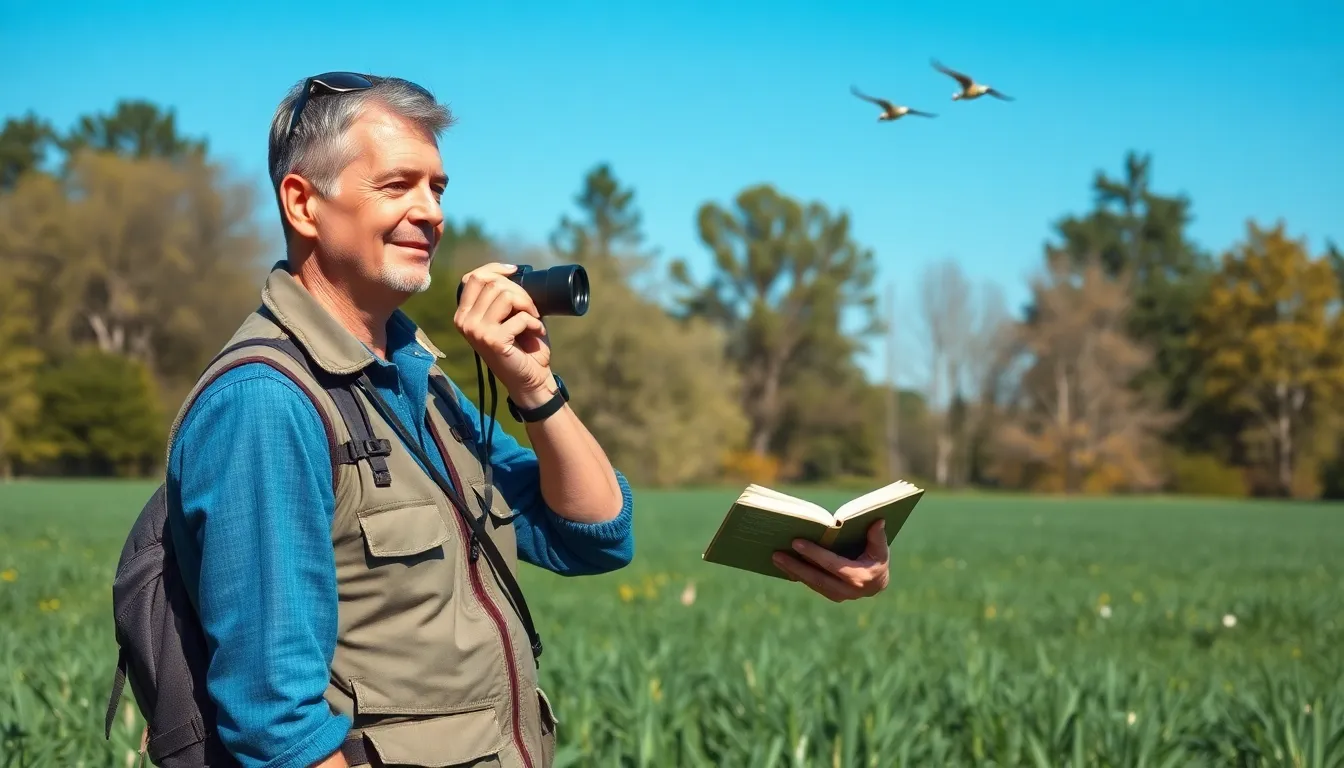
Modern bird watching journals become significantly more valuable when we combine traditional note-taking with digital resources and identification tools.
Cross-Reference with Identification Resources
We recommend keeping field guides nearby to verify our sightings immediately after recording them. Popular guides like the Peterson Field Guide or Sibley Guide to Birds help us confirm species identification and note exact field marks we might have missed. Digital field guides through apps such as Merlin Bird ID or eBird mobile provide instant access to photos, sounds, and range maps that enhance our journal entries.
Comparing our sketches and written descriptions with professional illustrations strengthens our identification skills over time. We should note the page number or app reference directly in our journal entries for future verification. Cross-referencing becomes particularly valuable when documenting rare species or unusual plumage variations that require additional confirmation.
Creating a personal reference system helps us track which resources we’ve consulted for each sighting. We can mark entries with symbols indicating whether we used field guides, apps, or expert confirmation to validate our observations.
Use Technology for Sound Recording
We can capture bird vocalizations using smartphone recording apps to complement our written descriptions of songs and calls. Apps like BirdNET or Merlin Sound ID automatically identify species from audio recordings, providing scientific verification for our journal entries. Recording capabilities prove especially useful during dawn chorus sessions when multiple species vocalize simultaneously.
Storing audio files with corresponding journal entries creates a multimedia record of our birding experiences. We should note the time, weather conditions, and bird behavior context alongside each recording for comprehensive documentation. Voice memos describing real-time observations while recording help us remember important details later.
Analyzing recorded sounds at home allows us to identify subtle differences between similar species calls. We can transcribe phonetic descriptions of unique vocalizations directly into our journal pages, building our personal audio identification library over time.
Integrate eBird Data Submissions
We enhance our personal journals by simultaneously submitting sighting data to eBird, creating both private records and contributions to citizen science. eBird’s mobile app allows us to record species counts, locations, and observation notes that we can later transfer to our physical journals. This dual recording system ensures our observations reach the global birding community while maintaining our personal documentation style.
eBird’s automatic location mapping helps us track our birding locations with precise GPS coordinates. We can export our eBird data periodically to analyze seasonal patterns and create year-end summaries for our journals. The platform’s species occurrence maps and bar charts provide additional context for our local observations.
Reviewing eBird’s suggested species for our location before each birding trip helps us prepare targeted journal pages. We can create checklists based on eBird predictions and note which expected species we encounter versus unexpected sightings that deserve special attention in our journals.
Review and Analyze Your Bird Watching Journal Entries
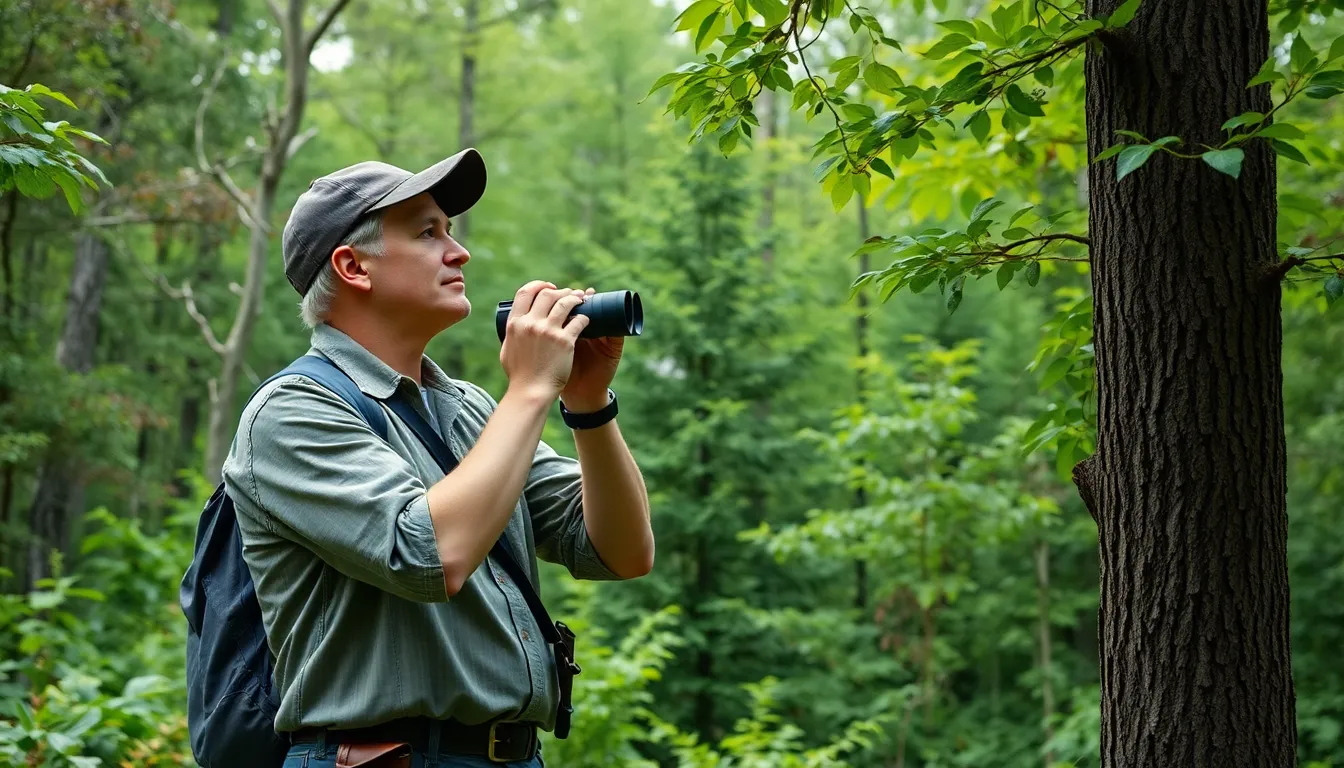
Regular analysis of our birding entries transforms casual observations into strategic insights. We’ll discover patterns in our data that can revolutionize future birding adventures and accelerate our skill development.
Identify Personal Birding Hotspots
Mapping our most productive locations reveals consistent patterns that lead to better birding experiences. We create a simple tally system by counting species observed at each location over multiple visits, identifying spots where diversity consistently exceeds our average sightings.
Recording seasonal variations at different locations helps us understand when exact habitats peak in activity. Our wetland entries might show highest waterfowl diversity during spring migration, while forest locations excel during fall warbler movements.
Tracking environmental conditions that coincide with exceptional birding days guides future planning. We note weather patterns, temperature ranges, and wind directions that consistently produce memorable sightings at our favorite spots.
Creating location scorecards using simple metrics like species count, rare bird frequency, and behavioral observations streamlines our site selection process. This data driven approach eliminates guesswork when choosing where to spend our limited birding time.
| Location Analysis Metrics | Example Data |
|---|---|
| Average Species per Visit | 15-25 birds |
| Peak Activity Times | 7-9 AM, 4-6 PM |
| Best Seasonal Windows | March-May, September-November |
| Weather Sweet Spots | Light winds, partly cloudy |
Track Skill Development Over Time
Reviewing identification confidence levels across journal entries reveals our growing expertise with exact bird families. We mark entries where we initially struggled with warbler identification, then celebrate later entries showing increased certainty and speed.
Documenting behavioral observation details demonstrates our evolving field skills beyond basic identification. Early entries might simply note “robin feeding,” while recent observations describe exact foraging techniques, social interactions, and habitat preferences.
Analyzing our sketch quality progression provides visual proof of developing artistic abilities and observational skills. We compare early attempts at capturing bird proportions with more recent detailed drawings showing improved understanding of anatomy and field marks.
Recording response times for common species identification shows measurable improvement in field recognition. Our journal entries shift from lengthy deliberation notes to confident instant identifications for familiar local birds.
Plan Future Birding Expeditions
Studying migration timing patterns from previous years helps us predict optimal windows for upcoming seasons. We identify peak dates for target species arrivals and departures, creating a personalized birding calendar based on our local observations.
Analyzing missed species opportunities reveals gaps in our birding strategy that future trips can address. Our journal entries highlight birds we’ve heard but not seen, weather conditions that prevented good observations, or locations we visited at suboptimal times.
Reviewing equipment effectiveness notes guide gear decisions for future outings. We track which binocular settings worked best in different conditions, camera lens performance for distant subjects, and field guide usefulness for exact identification challenges.
Creating target species lists based on habitat preferences and seasonal patterns documented in our entries increases expedition success rates. Our historical data shows which locations and conditions consistently produce our most wanted species sightings.
Share Your Bird Watching Journal Discoveries
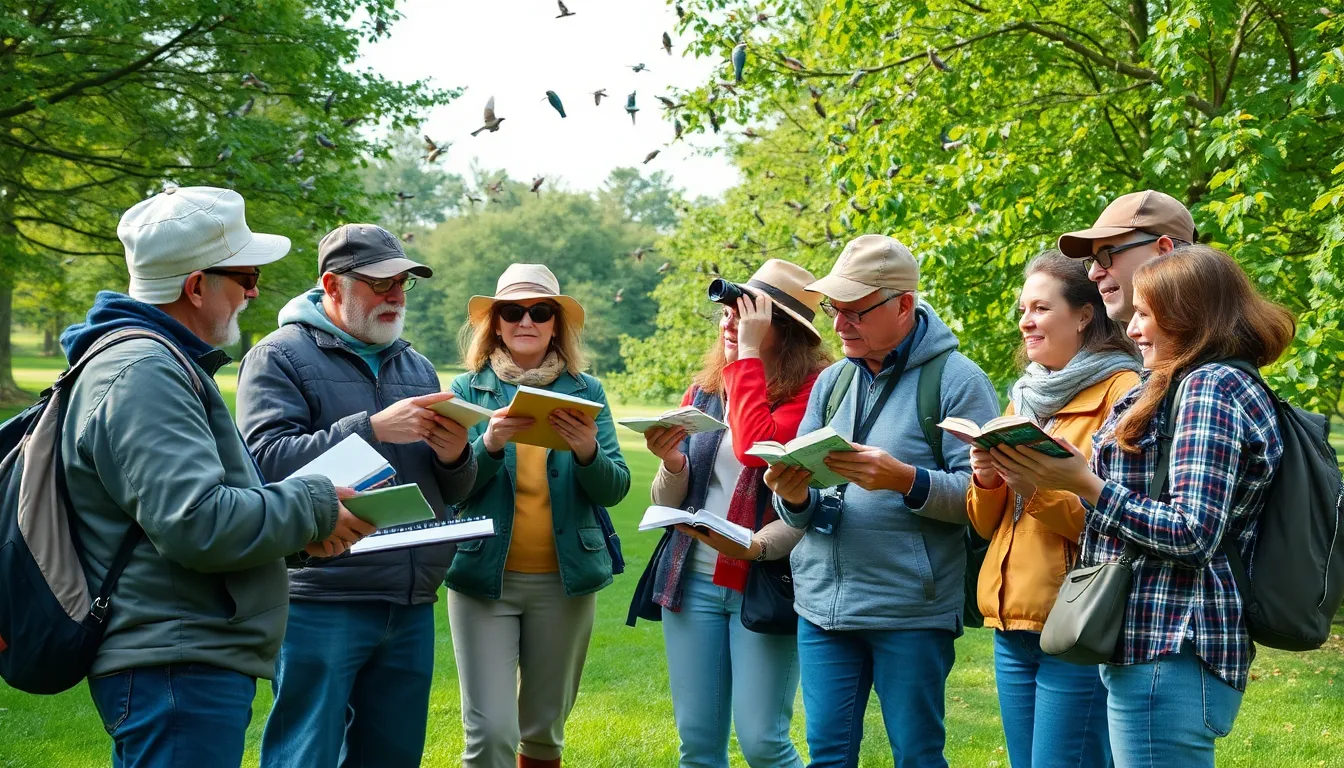
Sharing our bird watching journal discoveries amplifies the impact of our observations beyond personal enjoyment. Our documented sightings become valuable contributions to scientific research and community knowledge when we share them strategically.
Contributing to Citizen Science Projects
Contributing to eBird transforms our journal entries into powerful scientific data. We can upload our observations directly from our journals to this Cornell Lab platform, where researchers use our data to track bird populations and migration patterns. Scientists rely on citizen contributions like ours to monitor species distribution changes and identify conservation priorities.
Participating in Christmas Bird Counts extends our journal’s scientific value. We join thousands of birders worldwide during this annual census, contributing our documented observations to the longest-running citizen science project in the industry. Our journal entries help us prepare for these counts by reviewing previous year’s sightings in the same areas.
Supporting breeding bird surveys multiplies our observation impact. We can volunteer for programs like the North American Breeding Bird Survey, using our journal data to establish baseline populations in our local areas. Our consistent documentation helps scientists understand breeding success rates and habitat preferences.
Joining project-exact initiatives targets conservation efforts. We contribute to focused studies like hawk migration counts, owl surveys, or rare species monitoring programs. Our detailed journal observations provide the exact behavioral and habitat data these specialized projects need.
Joining Local Birding Communities
Connecting with local Audubon chapters enriches our journaling experience. We share our discoveries during monthly meetings and contribute our observations to chapter newsletters and websites. Fellow birders often visit locations we’ve documented in our journals, creating a network of shared knowledge.
Participating in birding festivals showcases our journal discoveries. We bring our journals to events where we can share unique sightings and learn from other birders’ experiences. These gatherings often feature workshops where we can improve our documentation techniques and discover new journaling methods.
Organizing journal sharing sessions builds community connections. We host informal meetups where birders compare journal entries and discuss interesting observations. These sessions help us identify patterns across different journals and validate unusual sightings through peer review.
Mentoring new birders passes on our journaling knowledge. We guide beginners by sharing examples from our journals and teaching effective documentation techniques. Our experience helps newcomers avoid common mistakes and develop their own successful journaling systems.
Creating Annual Birding Reports
Compiling yearly species lists reveals our birding achievements. We review our journal entries to create comprehensive annual reports showing total species observed, new additions to our life list, and seasonal highlights. These summaries help us set goals for the following year and track our progress as birders.
Analyzing seasonal trends improves our future birding plans. We create charts and graphs from our journal data showing peak migration dates, breeding activity periods, and weather correlations. This analysis guides our planning for optimal birding times and helps us predict when target species might appear.
Documenting location productivity guides our birding choices. We rank our birding spots based on journal entries, identifying which locations produce the most species throughout different seasons. Our annual reports help us allocate time efficiently and discover patterns we might miss during daily observations.
Sharing reports with local organizations contributes to regional knowledge. We submit our annual summaries to bird clubs, nature centers, and wildlife agencies that compile regional birding data. Our documented observations become part of the historical record for our local birding areas and contribute to long-term population studies.
Conclusion
Starting and maintaining a bird watching journal transforms every outdoor adventure into a meaningful scientific try. We’ve explored how proper documentation techniques create lasting memories while contributing valuable data to conservation efforts worldwide.
Your journal becomes more than just a record—it’s a personal field guide that grows with each outing. Whether you choose physical notebooks digital platforms or a hybrid approach the key is consistency in recording observations.
The techniques we’ve covered will help you develop a systematic approach to birding that enhances both identification skills and environmental awareness. From sketching field marks to tracking migration patterns your journal becomes an invaluable resource for years to come.
Remember that every entry matters regardless of whether you’re documenting common backyard visitors or rare vagrant species. Your observations contribute to a larger understanding of bird populations and help preserve these incredible creatures for future generations of birders to enjoy.
Frequently Asked Questions
What is a bird watching journal and why should I keep one?
A bird watching journal is a personal record of your bird sightings and observations. It transforms fleeting bird encounters into lasting memories and valuable data, serving as your personal field guide. Keeping a journal enhances your birding experience by helping you track patterns, improve identification skills, and contribute to citizen science projects.
Do I need special skills or expensive equipment to start a bird watching journal?
No special skills or expensive equipment are required to start a bird watching journal. You can begin with basic materials like a notebook and pen. The key is consistency in recording your observations, not fancy tools or artistic abilities.
Should I use a physical journal or digital format?
Both formats have advantages. Physical journals offer tactile satisfaction and work well in the field, while digital journals provide search capabilities and cloud storage. A hybrid approach works best – use a pocket notebook for field notes, then transfer information to a digital platform for long-term storage and analysis.
What essential information should I record for each bird sighting?
Record species identification (common and scientific names), date, time, and location of the sighting. Include weather conditions, habitat description, and behavioral observations like feeding habits or vocalizations. Note your confidence level in identification and any distinctive field marks observed.
How should I organize my bird watching journal for easy reference?
Create alphabetical species index pages and track first sightings to celebrate milestones. Develop a personal coding system with standardized abbreviations for gender, behavior, and weather symbols. Use maps to mark birding locations and record GPS coordinates for future reference.
Should I include sketches and photos in my journal?
Yes, visual documentation greatly enhances your journal’s value. Include field sketches of distinguishing features and integrate photographs when possible. Even quick sketches help with identification and create lasting memories. Document feathers, tracks, and other physical evidence you encounter.
How can I track seasonal patterns and migration data?
Create monthly species counts to reveal population trends and predict optimal birding times. Record first and last sighting dates to build a personal migration calendar. Document breeding season observations like courtship displays and nest building to understand local habitat quality.
What digital tools can enhance my bird watching journal?
Use field guide apps like Merlin Bird ID for instant identification help. Record bird vocalizations with your smartphone for later analysis. Submit your sightings to eBird to contribute to citizen science while accessing powerful data analysis tools and seasonal trend information.
How can I share my bird watching journal discoveries with others?
Contribute to citizen science projects like eBird and participate in Christmas Bird Counts. Connect with local birding communities to share discoveries and mentor new birders. Create annual birding reports to document your progress and contribute to regional conservation knowledge.
What size journal should I choose for field use?
Choose a pocket-sized journal for quick field notes and portability. Consider weather-resistant features like waterproof paper and durable covers. For comprehensive documentation, use larger formats at home. The key is finding a balance between portability and space for detailed observations.









